2012 TOYOTA YARIS HYBRID automatic transmission
[x] Cancel search: automatic transmissionPage 209 of 704
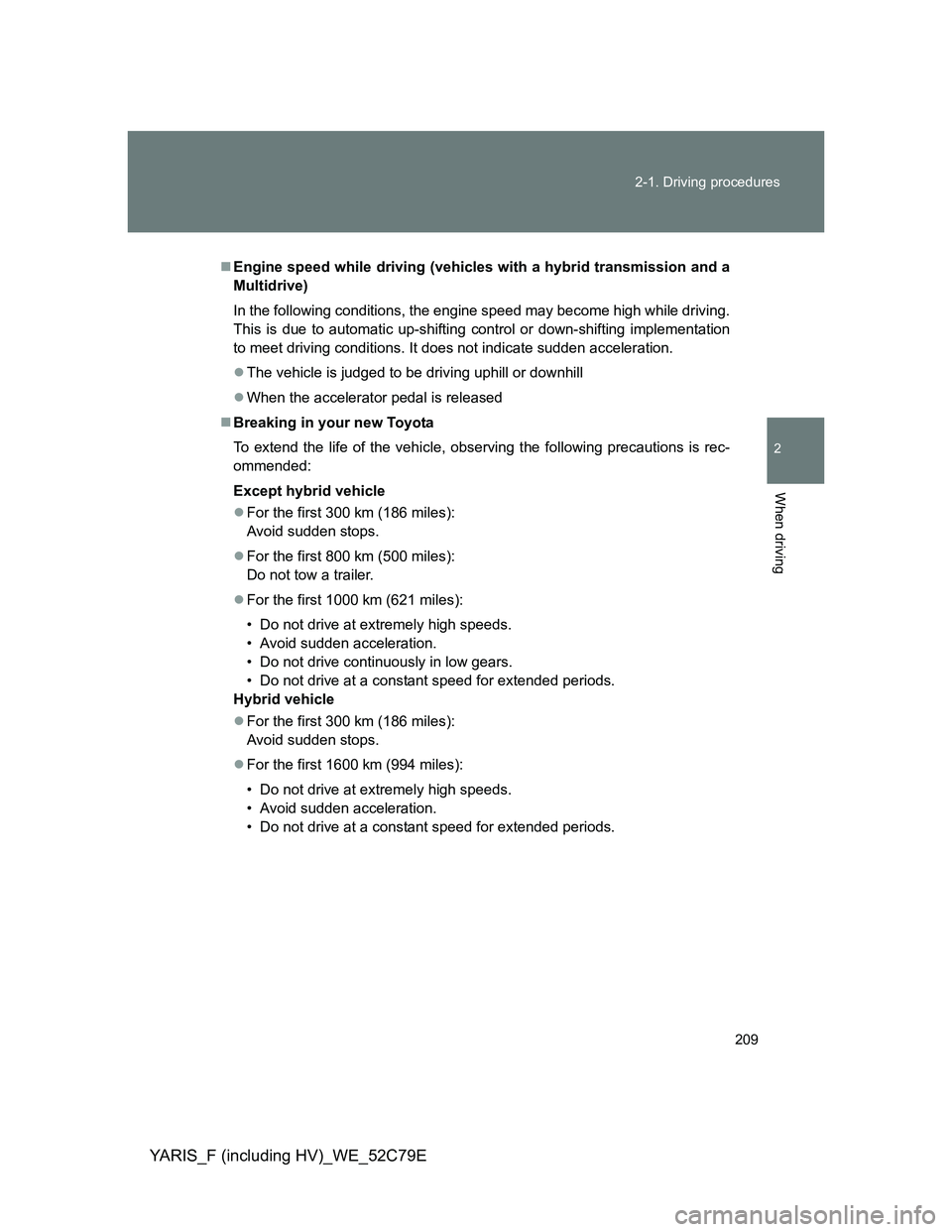
209 2-1. Driving procedures
2
When driving
YARIS_F (including HV)_WE_52C79E
Engine speed while driving (vehicles with a hybrid transmission and a
Multidrive)
In the following conditions, the engine speed may become high while driving.
This is due to automatic up-shifting control or down-shifting implementation
to meet driving conditions. It does not indicate sudden acceleration.
The vehicle is judged to be driving uphill or downhill
When the accelerator pedal is released
Breaking in your new Toyota
To extend the life of the vehicle, observing the following precautions is rec-
ommended:
Except hybrid vehicle
For the first 300 km (186 miles):
Avoid sudden stops.
For the first 800 km (500 miles):
Do not tow a trailer.
For the first 1000 km (621 miles):
• Do not drive at extremely high speeds.
• Avoid sudden acceleration.
• Do not drive continuously in low gears.
• Do not drive at a constant speed for extended periods.
Hybrid vehicle
For the first 300 km (186 miles):
Avoid sudden stops.
For the first 1600 km (994 miles):
• Do not drive at extremely high speeds.
• Avoid sudden acceleration.
• Do not drive at a constant speed for extended periods.
Page 233 of 704
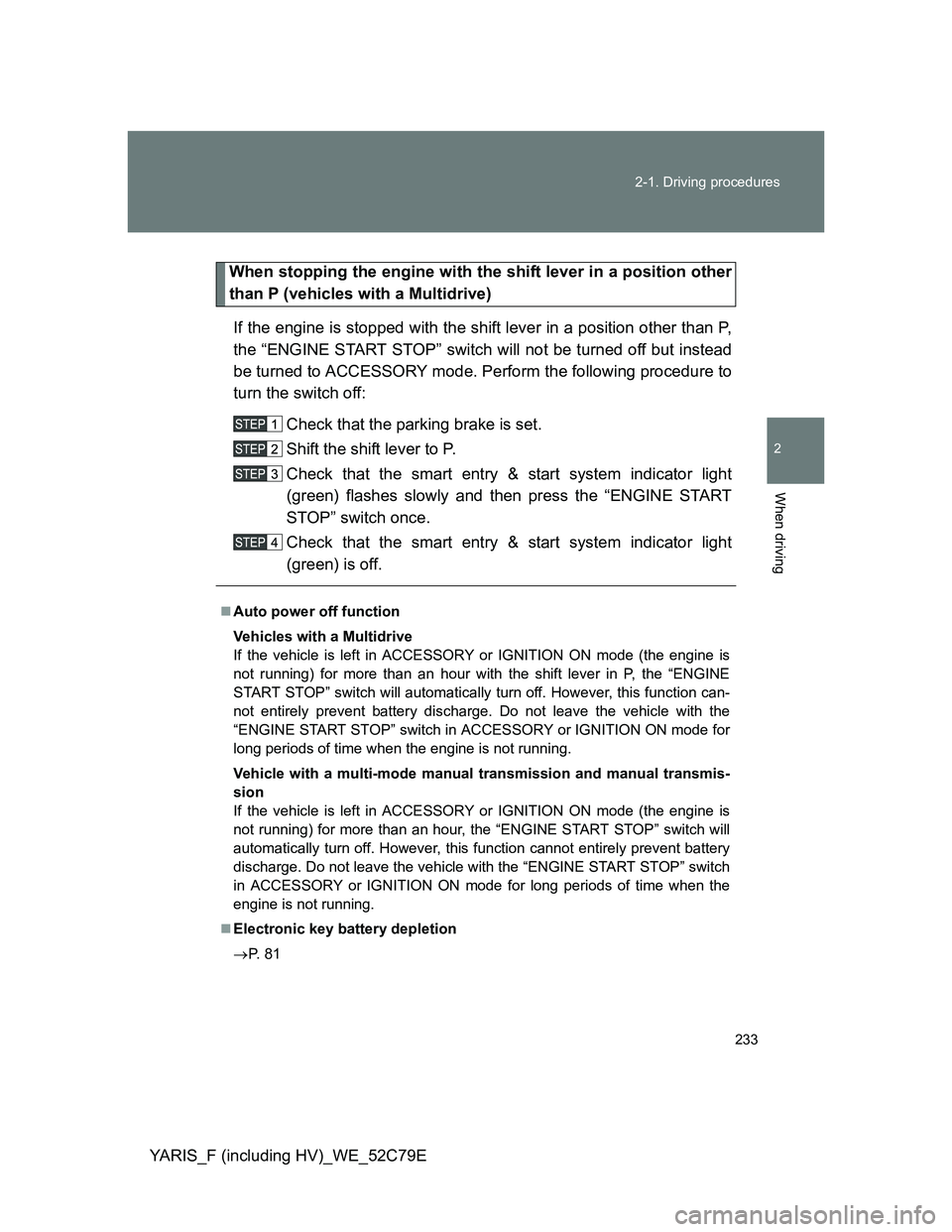
233 2-1. Driving procedures
2
When driving
YARIS_F (including HV)_WE_52C79E
When stopping the engine with the shift lever in a position other
than P (vehicles with a Multidrive)
If the engine is stopped with the shift lever in a position other than P,
the “ENGINE START STOP” switch will not be turned off but instead
be turned to ACCESSORY mode. Perform the following procedure to
turn the switch off:
Check that the parking brake is set.
Shift the shift lever to P.
Check that the smart entry & start system indicator light
(green) flashes slowly and then press the “ENGINE START
STOP” switch once.
Check that the smart entry & start system indicator light
(green) is off.
Auto power off function
Vehicles with a Multidrive
If the vehicle is left in ACCESSORY or IGNITION ON mode (the engine is
not running) for more than an hour with the shift lever in P, the “ENGINE
START STOP” switch will automatically turn off. However, this function can-
not entirely prevent battery discharge. Do not leave the vehicle with the
“ENGINE START STOP” switch in ACCESSORY or IGNITION ON mode for
long periods of time when the engine is not running.
Vehicle with a multi-mode manual transmission and manual transmis-
sion
If the vehicle is left in ACCESSORY or IGNITION ON mode (the engine is
not running) for more than an hour, the “ENGINE START STOP” switch will
automatically turn off. However, this function cannot entirely prevent battery
discharge. Do not leave the vehicle with the “ENGINE START STOP” switch
in ACCESSORY or IGNITION ON mode for long periods of time when the
engine is not running.
Electronic key battery depletion
P. 8 1
Page 234 of 704
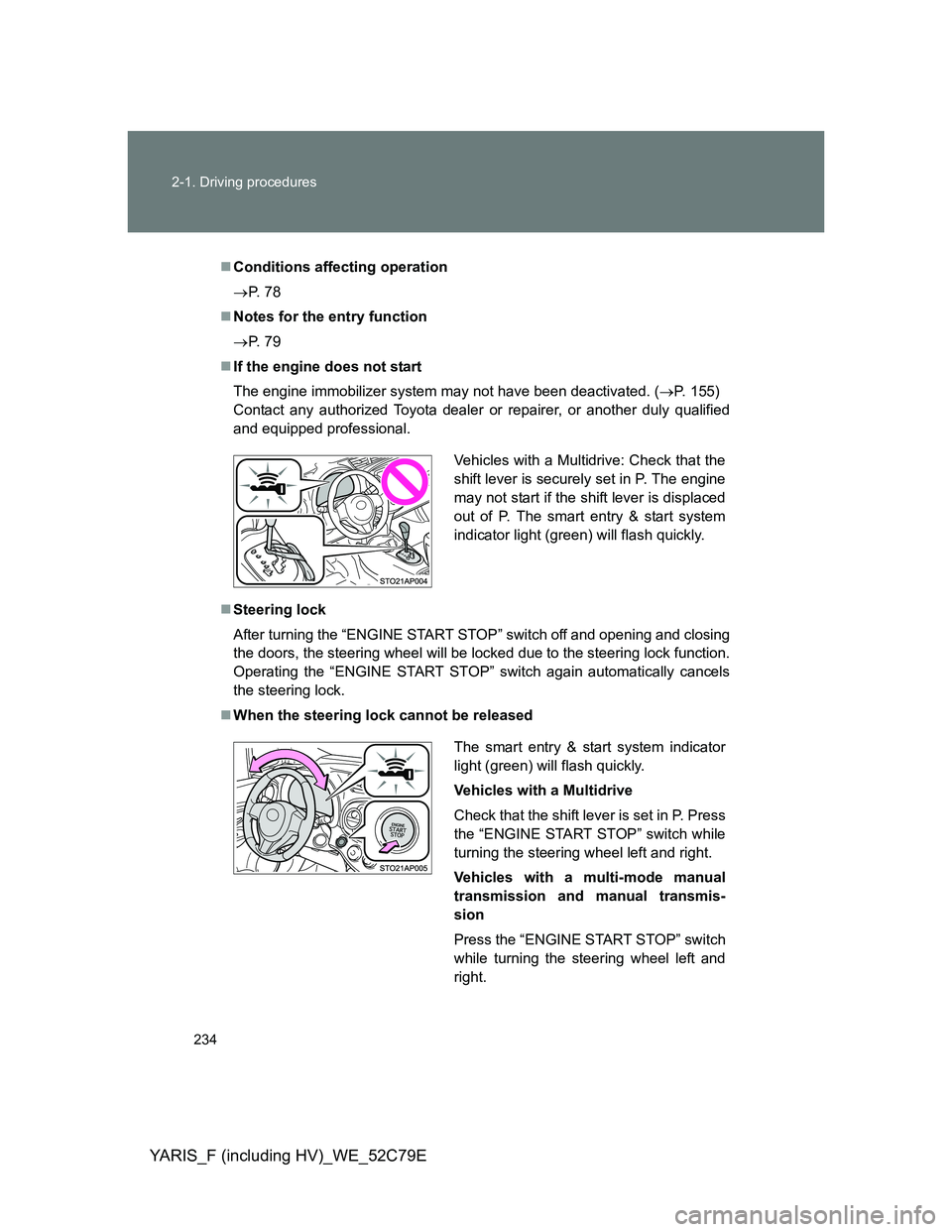
234 2-1. Driving procedures
YARIS_F (including HV)_WE_52C79E
Conditions affecting operation
P. 7 8
Notes for the entry function
P. 7 9
If the engine does not start
The engine immobilizer system may not have been deactivated. (P. 155)
Contact any authorized Toyota dealer or repairer, or another duly qualified
and equipped professional.
Steering lock
After turning the “ENGINE START STOP” switch off and opening and closing
the doors, the steering wheel will be locked due to the steering lock function.
Operating the “ENGINE START STOP” switch again automatically cancels
the steering lock.
When the steering lock cannot be released
Vehicles with a Multidrive: Check that the
shift lever is securely set in P. The engine
may not start if the shift lever is displaced
out of P. The smart entry & start system
indicator light (green) will flash quickly.
The smart entry & start system indicator
light (green) will flash quickly.
Vehicles with a Multidrive
Check that the shift lever is set in P. Press
the “ENGINE START STOP” switch while
turning the steering wheel left and right.
Vehicles with a multi-mode manual
transmission and manual transmis-
sion
Press the “ENGINE START STOP” switch
while turning the steering wheel left and
right.
Page 259 of 704
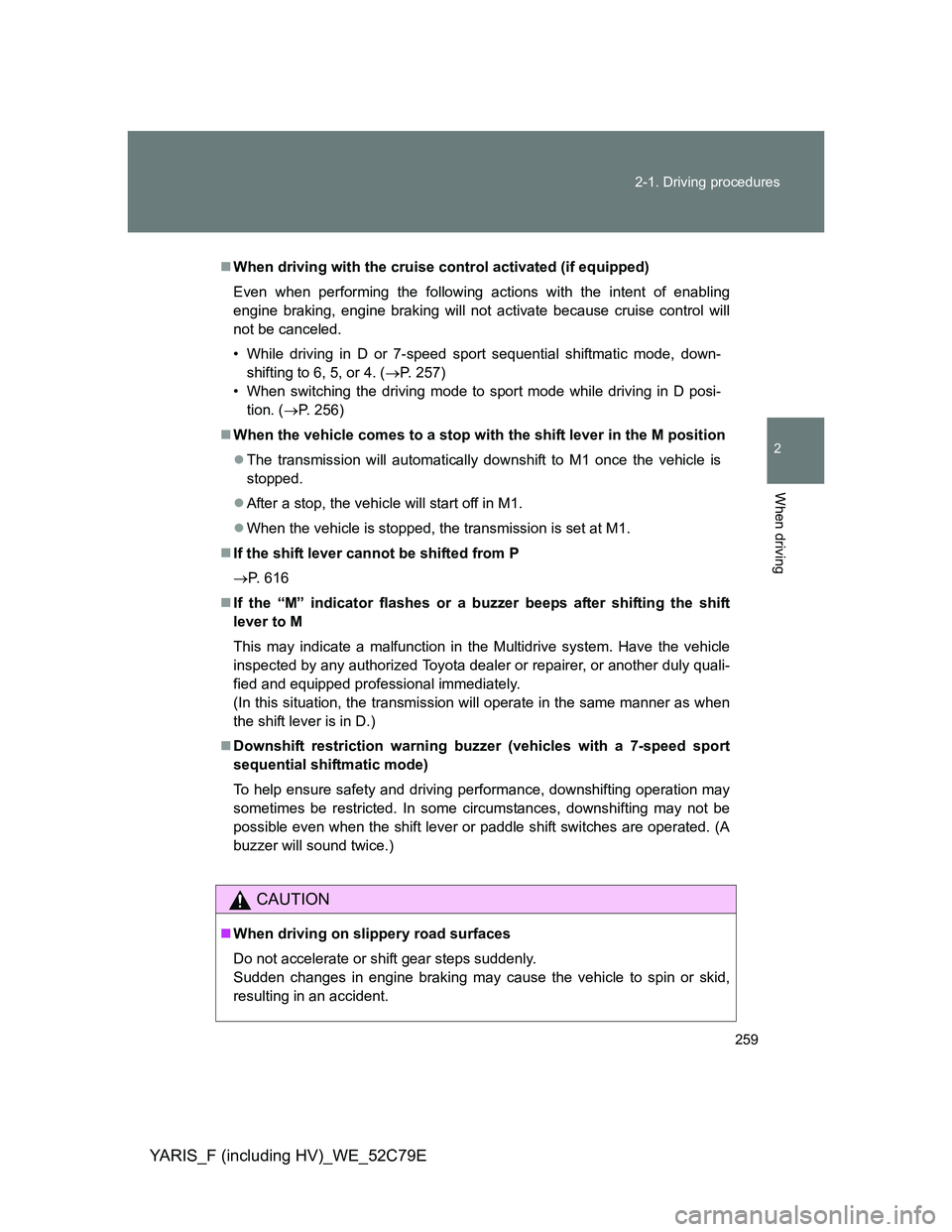
259 2-1. Driving procedures
2
When driving
YARIS_F (including HV)_WE_52C79E
When driving with the cruise control activated (if equipped)
Even when performing the following actions with the intent of enabling
engine braking, engine braking will not activate because cruise control will
not be canceled.
• While driving in D or 7-speed sport sequential shiftmatic mode, down-
shifting to 6, 5, or 4. (P. 257)
• When switching the driving mode to sport mode while driving in D posi-
tion. (P. 256)
When the vehicle comes to a stop with the shift lever in the M position
The transmission will automatically downshift to M1 once the vehicle is
stopped.
After a stop, the vehicle will start off in M1.
When the vehicle is stopped, the transmission is set at M1.
If the shift lever cannot be shifted from P
P. 616
If the “M” indicator flashes or a buzzer beeps after shifting the shift
lever to M
This may indicate a malfunction in the Multidrive system. Have the vehicle
inspected by any authorized Toyota dealer or repairer, or another duly quali-
fied and equipped professional immediately.
(In this situation, the transmission will operate in the same manner as when
the shift lever is in D.)
Downshift restriction warning buzzer (vehicles with a 7-speed sport
sequential shiftmatic mode)
To help ensure safety and driving performance, downshifting operation may
sometimes be restricted. In some circumstances, downshifting may not be
possible even when the shift lever or paddle shift switches are operated. (A
buzzer will sound twice.)
CAUTION
When driving on slippery road surfaces
Do not accelerate or shift gear steps suddenly.
Sudden changes in engine braking may cause the vehicle to spin or skid,
resulting in an accident.
Page 260 of 704
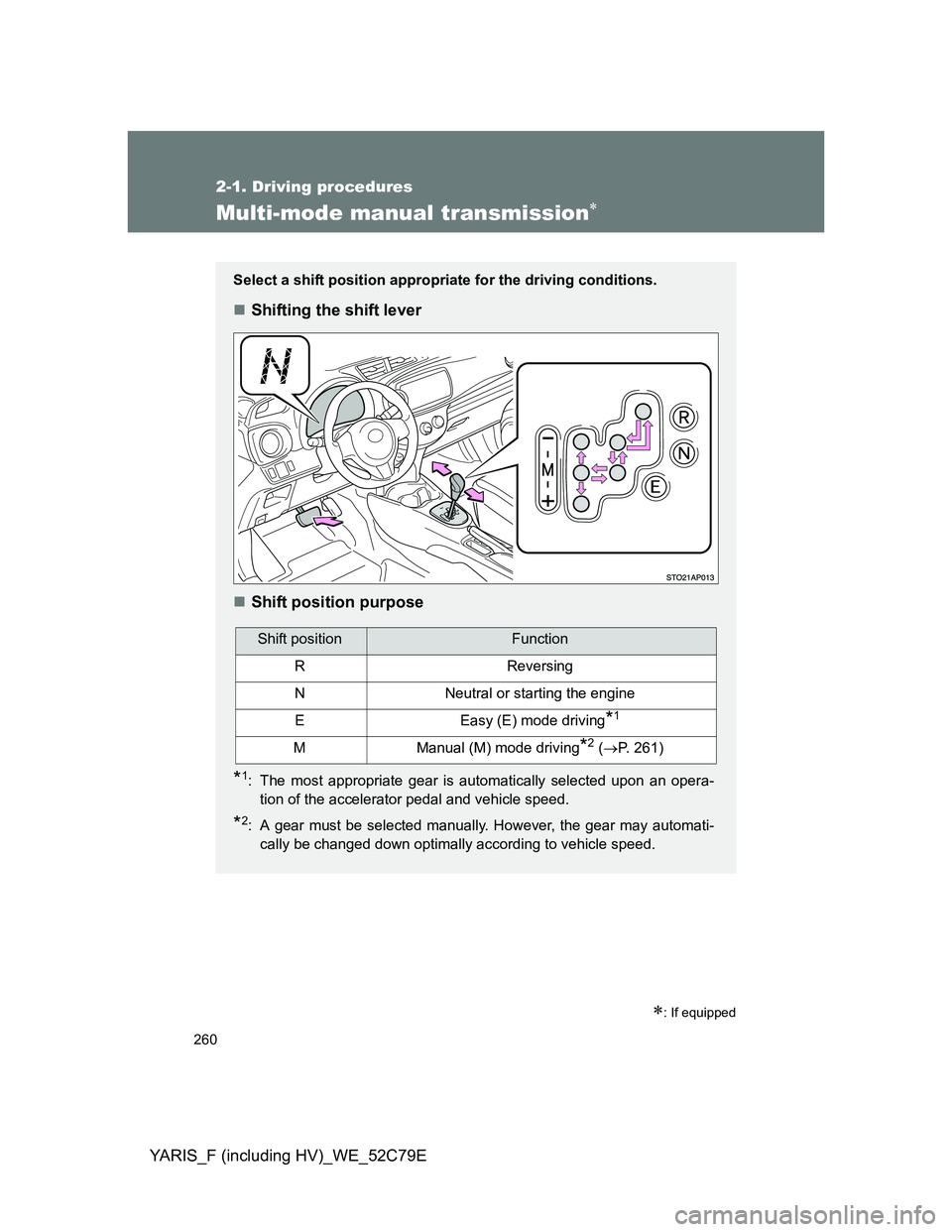
260
2-1. Driving procedures
YARIS_F (including HV)_WE_52C79E
Multi-mode manual transmission
: If equipped
Select a shift position appropriate for the driving conditions.
Shifting the shift lever
Shift position purpose
*1: The most appropriate gear is automatically selected upon an opera-
tion of the accelerator pedal and vehicle speed.
*2: A gear must be selected manually. However, the gear may automati-
cally be changed down optimally according to vehicle speed.
Shift positionFunction
RReversing
NNeutral or starting the engine
EEasy (E) mode driving*1
MManual (M) mode driving*2 (P. 261)
Page 313 of 704
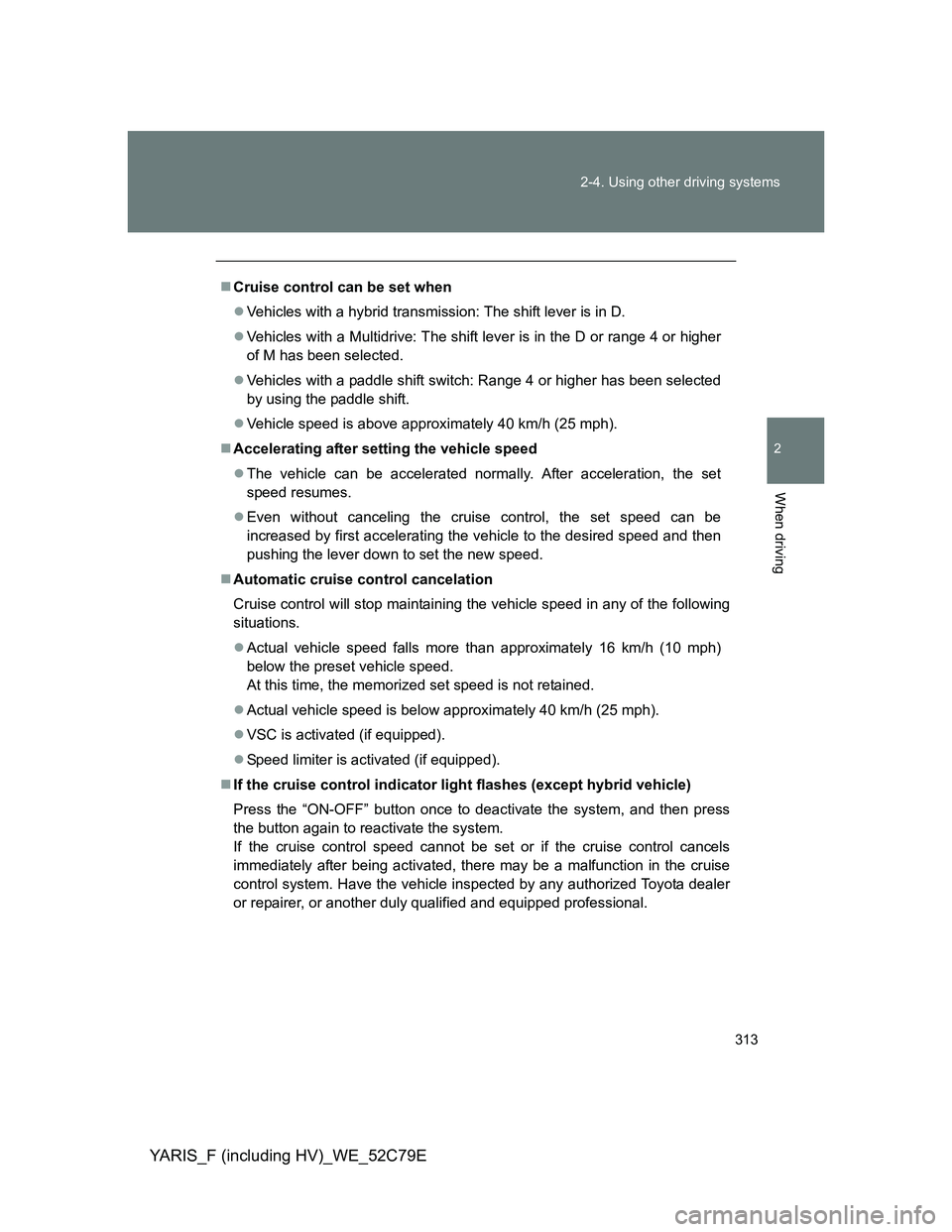
313 2-4. Using other driving systems
2
When driving
YARIS_F (including HV)_WE_52C79E
Cruise control can be set when
Vehicles with a hybrid transmission: The shift lever is in D.
Vehicles with a Multidrive: The shift lever is in the D or range 4 or higher
of M has been selected.
Vehicles with a paddle shift switch: Range 4 or higher has been selected
by using the paddle shift.
Vehicle speed is above approximately 40 km/h (25 mph).
Accelerating after setting the vehicle speed
The vehicle can be accelerated normally. After acceleration, the set
speed resumes.
Even without canceling the cruise control, the set speed can be
increased by first accelerating the vehicle to the desired speed and then
pushing the lever down to set the new speed.
Automatic cruise control cancelation
Cruise control will stop maintaining the vehicle speed in any of the following
situations.
Actual vehicle speed falls more than approximately 16 km/h (10 mph)
below the preset vehicle speed.
At this time, the memorized set speed is not retained.
Actual vehicle speed is below approximately 40 km/h (25 mph).
VSC is activated (if equipped).
Speed limiter is activated (if equipped).
If the cruise control indicator light flashes (except hybrid vehicle)
Press the “ON-OFF” button once to deactivate the system, and then press
the button again to reactivate the system.
If the cruise control speed cannot be set or if the cruise control cancels
immediately after being activated, there may be a malfunction in the cruise
control system. Have the vehicle inspected by any authorized Toyota dealer
or repairer, or another duly qualified and equipped professional.
Page 320 of 704

320 2-4. Using other driving systems
YARIS_F (including HV)_WE_52C79EIf the Stop & Start cancel switch is pressed while the vehicle is
stopped
When the engine is stopped by the Stop & Start system, press-
ing the Stop & Start cancel switch will restart the engine.
From the next time the vehicle is stopped (after Stop & Start sys-
tem has been turned off), the engine will not be stopped.
With the Stop & Start system disabled, pressing the Stop & Start
cancel switch will re-enable the system but not stop the engine.
From the next time the vehicle is stopped (after Stop & Start sys-
tem has been turned on), the engine will be stopped.
Operating conditions
The Stop & Start system is operational when all of the following condi-
tions are met:
• The engine is adequately warmed up.
• The battery is sufficiently charged.
• The driver’s door is closed.
• Vehicles with a Multidrive: The driver’s seat belt is fastened.
• The hood is closed.
• The accelerator pedal is not being depressed.
• The shift lever is not in R.
In the following circumstances the engine may not be stopped by the
Stop & Start system. This is not a malfunction of the Stop & Start system.
• Engine coolant temperature or transmission fluid temperature is too
low or too high.
• The air conditioning system is being used when the vehicle interior
temperature is extremely high such as after the vehicle was parked
under the hot sun.
• Vehicles with an automatic air conditioning system only: The wind-
shield defogger is being used.
• The battery is not sufficiently charged, or is undergoing a periodic
recharge.
• Due to traffic or other circumstances the vehicle is stopped repeatedly,
resulting in the amount of time the engine is stopped by the Stop &
Start system to become excessively high.
• The brake pedal is not depressed firmly.
Page 321 of 704

321 2-4. Using other driving systems
2
When driving
YARIS_F (including HV)_WE_52C79E
• The vehicle is stopped on a steep hill.
• The brake booster vacuum is low.
• A large amount of electricity is being used.
• At high altitude.
When the above conditions improve, the Stop & Start system will stop and
restart the engine from the next time the vehicle is stopped.
In the following situations, the engine may start even without the brake
pedal being released (vehicles with a Multidrive) or clutch pedal being
depressed (vehicles with a manual transmission).
• The brake pedal is pumped or strongly depressed.
• The air conditioning system is being used or turned on.
• Vehicles with an automatic air conditioning system only: The wind-
shield defogger is turned on.
• The battery is not sufficiently charged.
• The vehicle starts to roll on an incline.
• Vehicles with a Multidrive: The hood is opened when the shift lever is in
N or P.
• The accelerator pedal is depressed.
• A large amount of electricity is being used.
• Vehicles with a Multidrive: The driver’s door is opened.
• Vehicles with a Multidrive: The driver’s seat belt is unfastened.
In the following situations, it may take longer than normal for the Stop &
Start system to activate.
• The battery is discharged.
• After the battery terminals have been disconnected and reconnected
after a battery replacement, etc.
• The engine coolant temperature is low.
Automatic reactivation of the Stop & Start system
Vehicles without a smart entry & start system:
Even if the Stop & Start system is disabled by the Stop & Start cancel switch,
it will be automatically re-enabled once the engine switch is turned to the
“LOCK” position then to the “START” position.
Vehicles with a smart entry & start system:
Even if the Stop & Start system is disabled by the Stop & Start cancel switch,
it will be automatically re-enabled once the “ENGINE START STOP” switch
is turned off then the engine is started.